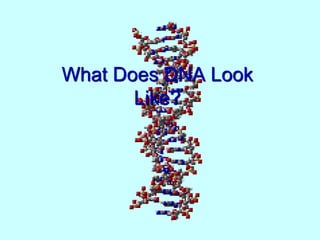
What does dna look like
- 1. What Does DNA Look Like?
- 2. The Pieces of the Puzzle
- 3. DNA is sometimes called "the blueprint of life" because it contains the code, or instructions for building an organism and ensuring that organism functions correctly. Just like a builder uses a blueprint to build a house, DNA is used as the blueprint, or plans, for the entire organism.
- 4. Scientists knew that the material that makes up genes must be able to do 2 things: 1. Give instructions for building and maintaining cells 2. Be able to be copied each time a cell divides and contain identical genes
- 5. It is the chemical component of chromosomes, which are located in the nucleus of every cell. Stretches of DNA (or stretches of chromosomes) code for genes. Gene - a segment of DNA that codes for a protein, which in turn codes for a trait (skin tone, eye color, etc), a gene is a stretch of DNA.
- 6. DNA is made up of subunits called nucleotides Nucleotide = consists of a sugar, a phosphate, and a base Four bases adenine, thymine, guanine, and cytosine (A, T, G, C) Each base has a different shape
- 8. Chargaff’s Rule In 1950’s, biochemist named Erwin Chargaff found that the amount of adenine in DNA always equals amount of thymine
- 9. Also found that amount of guanine always equals amount of cytosine Chargaff’s Rule helped scientists understand the structure of DNA
- 10. Franklin’s Discovery Chemist Rosalind Franklin was able to make images of DNA molecules
- 11. X ray diffraction = X rays are aimed at DNA molecules and the ray bounces off The pattern made by the bouncing rays is captured on film, suggesting that DNA has a spiral shape
- 12. Watson and Crick’s Model James Watson and Francis Crick used Franklin’s X ray images to conclude that DNA must look like a long, twisted ladder
- 13. They built a model of DNA in their laboratory
- 14. DNA’s Double Helix Double helix = shaped like a twisted ladder Two sides of the ladder are made up of alternating sugar parts and phosphate parts
- 15. Each rung of the ladder is made of a pair of bases The rungs of the ladder can occur in any order (as long as the base-pair rule is followed)—A always with T, G always with C
- 16. For instance, a stretch of DNA could be AATGACCAT (which would code for a different gene than a stretch that read: GGGCCATAG). All in all, there are billions of bases in cells, which code for all the things an organism needs to function.
- 17. Making Copies of DNA The pairing of bases allows the cell to “replicate”, or make copies of, DNA Pairs of bases are complementary— meaning they only pair with each other, and both sides of the DNA ladder pair together
- 18. How Copies are Made During replication (copying process), DNA molecule splits down the middle, where the bases meet The bases on each side of the molecule are used as a pattern for a new strand
- 19. As the bases are exposed, complementary nucleotides are added to each side of the ladder Two DNA molecules are formed half of each DNA is old and half is new
- 20. When Copies are Made DNA is copied every time a cell divides The job of unwinding, copying, and re- winding the DNA is done by proteins within the cell
- 21. DNA is usually found with several kinds of proteins Other proteins help with the process of carrying out the instructions written in the code of DNA
- 22. Scientists’ Contributions Erwin Chargaff: discovered base-pair rule Rosalind Franklin: used X-rays to find DNA’s spiral shape Watson and Crick: built 3-D model of DNA